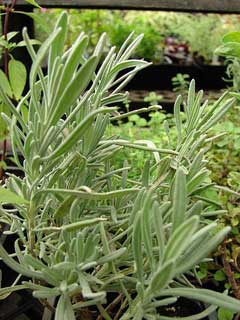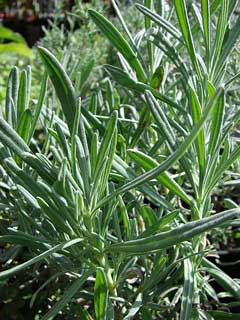 |
|
http://www.hear.org/starr/ |
 |
| http://www.hear.org/starr/Idesia polycarpa |
Translate this page:
Summary
Bloom Color: Purple. Main Bloom Time: Early fall, Late summer, Mid summer. Form: Rounded.
Physical Characteristics

 Lavandula x intermedia is an evergreen Shrub growing to 1.2 m (4ft) by 1 m (3ft 3in) at a slow rate.
Lavandula x intermedia is an evergreen Shrub growing to 1.2 m (4ft) by 1 m (3ft 3in) at a slow rate.
See above for USDA hardiness. It is hardy to UK zone 5. It is in leaf all year, in flower from July to September, and the seeds ripen from August to October. The species is hermaphrodite (has both male and female organs) and is pollinated by Bees, Lepidoptera (Moths & Butterflies).
It is noted for attracting wildlife.
Suitable for: light (sandy), medium (loamy) and heavy (clay) soils and prefers well-drained soil. Suitable pH: mildly acid, neutral and basic (mildly alkaline) soils and can grow in very alkaline and saline soils.
It cannot grow in the shade. It prefers dry or moist soil and can tolerate drought. The plant can tolerate maritime exposure.
UK Hardiness Map
US Hardiness Map
Synonyms
Plant Habitats
Hedge; Cultivated Beds; East Wall. In. South Wall. In. West Wall. In.
Edible Uses
Edible Parts:
Edible Uses: Condiment Tea
The following uses are for L. angustifolia, they should also apply to this hybrid:- Leaves, petals and flowering tips - raw. Used as a condiment in salads, soups, stews etc[2, 15, 183]. They provide a very aromatic flavour[7] and are too strong to be used in any quantity[K]. The fresh or dried flowers are used as a tea[183]. The fresh flowers are also crystallized or added to jams, ice-creams, vinegars etc as a flavouring[238]. An essential oil from the flowers is used as a food flavouring[183].
References More on Edible Uses
Medicinal Uses
Plants For A Future can not take any responsibility for any adverse effects from the use of plants. Always seek advice from a professional before using a plant medicinally.
Antihalitosis Antiseptic Antispasmodic Aromatherapy Aromatic Carminative Cholagogue Diuretic
Nervine Sedative Stimulant Stomachic Tonic
The following uses are for L. angustifolia, they should also apply to this hybrid:- Lavender is a commonly used household herbal remedy. An essential oil obtained from the flowers is antihalitosis, antiseptic, antispasmodic, aromatic, carminative, cholagogue, diuretic, nervine, sedative, stimulant, stomachic and tonic[4, 7, 9, 21, 165, 238]. It is not often used internally, though it is a useful carminative and nervine[4]. It is mainly used externally where it is an excellent restorative and tonic - when rubbed into the temples, for example, it can cure a nervous headache, and it is a delightful addition to the bath-water[4]. Its antiseptic properties also make it useful in the treatment of burns, sunburn, scalds, bites, vaginal discharge, anal fissure etc, where it also soothes the affected part of the body and can prevent the formation of permanent scar tissue[4, 238]. The essential oil is used in aromatherapy. Its keyword is 'Immune system'[210].
References More on Medicinal Uses
The Bookshop: Edible Plant Books
Our Latest books on Perennial Plants For Food Forests and Permaculture Gardens in paperback or digital formats.

Edible Tropical Plants
Food Forest Plants for Hotter Conditions: 250+ Plants For Tropical Food Forests & Permaculture Gardens.
More

Edible Temperate Plants
Plants for Your Food Forest: 500 Plants for Temperate Food Forests & Permaculture Gardens.
More

More Books
PFAF have eight books available in paperback and digital formats. Browse the shop for more information.
Shop Now
Other Uses
Companion Essential Hedge Hedge Incense Pot-pourri Repellent
The following uses are for the closely related L. angustifolia, they should also apply to this hybrid:- The essential oil that is obtained from the flowers is exquisitely scented and has a very wide range of applications, both in the home and commercially. It is commonly used in soap making, in making high quality perfumes (it is also used in 'Eau de Cologne'), it is also used as a detergent and cleaning agent, a food flavouring etc[21, 46, 57, 171, 238] and as an insect repellent[201]. Yields of 0.8 - 1% of the oil are obtained[7]. When growing the plant for its essential oil content, it is best to harvest the flowering stems as soon as the flowers have faded[245]. The aromatic leaves and flowers are used in pot-pourri[238] and as an insect repellent in the linen cupboard etc[14, 18, 20]. They are also said to repel mice[20]. The flowering stems, once the flowers have been removed for use in pot-pourri etc, can be tied in small bundles and burnt as incense sticks[245]. Can be grown as a low hedge, responding well to trimming[29].
Special Uses
Attracts Wildlife Food Forest Hedge Hedge Scented Plants
References More on Other Uses
Cultivation details
Landscape Uses:Alpine garden, Border, Container, Ground cover, Massing, Rock garden, Seashore, Specimen. Succeeds in almost any soil so long as it is well-drained and not too acid[1, 200]. Prefers a sunny position in a neutral to alkaline soil[1, 4, 14]. Prefers a light warm dry soil[37]. When grown in rich soils the plants tend to produce more leaves but less essential oils[4]. Established plants are drought tolerant[190]. Very tolerant of salt wind exposure[K]. When growing for maximum essential oil content, the plant must be given a very warm sunny position and will do best in a light sandy soil, the fragrance being especially pronounced in a chalky soil[245]. Plants are hardy to between -10 and -15°c[184]. Lavender is a very ornamental plant that is often grown in the herb garden and is also grown commercially for its essential oil[1, 4]. This species is a very variable hybrid between the two main species of lavender, L. angustifolia and L. latifolia[200], There are several named varieties[200, 238]. Not a very long-lived plant, it can be trimmed to keep it tidy but is probably best replaced every 10 years[200]. Any trimming is best done in spring and should not be done in the autumn since this can encourage new growth that will not be very cold-hardy[200]. A good bee plant, also attracting butterflies and moths[7, 24, 30]. Lavender makes a good companion for most plants[54], growing especially well with cabbages[14]. Special Features:
Attractive foliage, Fragrant foliage, Not North American native, Attracts butterflies, Suitable for cut flowers, Suitable for dried flowers, Extended bloom season in Zones 9A and above, Fragrant flowers, Attractive flowers or blooms.
References Carbon Farming Information and Carbon Sequestration Information
Temperature Converter
Type a value in the Celsius field to convert the value to Fahrenheit:
Fahrenheit:
The PFAF Bookshop
Plants For A Future have a number of books available in paperback and digital form. Book titles include Edible Plants, Edible Perennials, Edible Trees,Edible Shrubs, Woodland Gardening, and Temperate Food Forest Plants. Our new book is Food Forest Plants For Hotter Conditions (Tropical and Sub-Tropical).
Shop Now
Plant Propagation
Seed - sow spring in a greenhouse and only just cover the seed[4]. It usually germinates in 1 - 3 months at 15°c. When large enough to handle, prick the seedlings out into individual pots and grow them on in the greenhouse or cold frame for their first winter, planting them out in late spring after the last expected frosts. This species is a hybrid and will not come true from seed. Cuttings of half-ripe wood 7 - 10cm with a heel, July/August in a frame. Usually very east, a high percentage will root within a few weeks[78]. Grow them on in the greenhouse for their first winter and plant them out in late spring after the last expected frosts. Cuttings 7cm with a heel succeed at almost any time of the year[1]. Layering.
Other Names
If available other names are mentioned here
Native Plant Search
Search over 900 plants ideal for food forests and permaculture gardens. Filter to search native plants to your area. The plants selected are the plants in our book 'Plants For Your Food Forest: 500 Plants for Temperate Food Forests and Permaculture Gardens, as well as plants chosen for our forthcoming related books for Tropical/Hot Wet Climates and Mediterranean/Hot Dry Climates. Native Plant Search
Found In
Countries where the plant has been found are listed here if the information is available
Weed Potential
Right plant wrong place. We are currently updating this section.
Please note that a plant may be invasive in one area but may not in your area so it’s worth checking.
Conservation Status
IUCN Red List of Threatened Plants Status :

Growth: S = slow M = medium F = fast. Soil: L = light (sandy) M = medium H = heavy (clay). pH: A = acid N = neutral B = basic (alkaline). Shade: F = full shade S = semi-shade N = no shade. Moisture: D = dry M = Moist We = wet Wa = water.

Expert comment
Author
Emeric. ex Loisel.
Botanical References
200
Links / References
For a list of references used on this page please go here
Readers comment
| Add a comment |
|
If you have important information about this plant that may help other users please add a comment or link below. Only comments or links that are felt to be directly relevant to a plant will be included. If you think a comment/link or information contained on this page is inaccurate or misleading we would welcome your feedback at [email protected]. If you have questions about a plant please use the Forum on this website as we do not have the resources to answer questions ourselves.
* Please note: the comments by website users are not necessarily those held by PFAF and may give misleading or inaccurate information.
To leave a comment please Register or login here All comments need to be approved so will not appear immediately.
|
Subject : Lavandula x intermedia
|
|
|
|